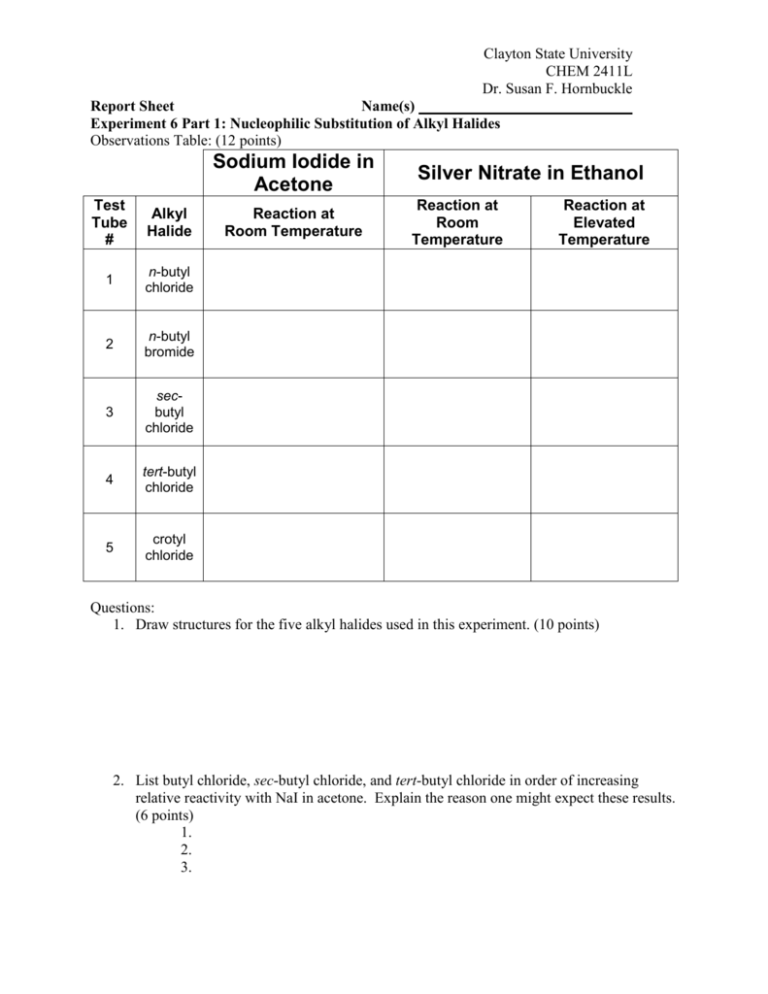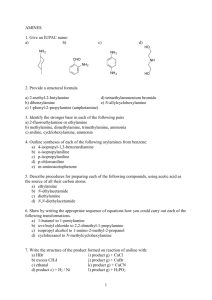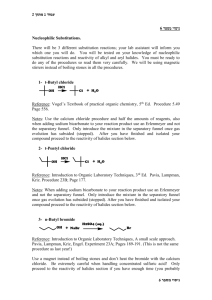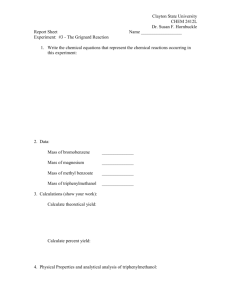Report Sheet #6
advertisement

Clayton State University CHEM 2411L Dr. Susan F. Hornbuckle Report Sheet Name(s) Experiment 6 Part 1: Nucleophilic Substitution of Alkyl Halides Observations Table: (12 points) Sodium Iodide in Acetone Test Tube # Alkyl Halide 1 n-butyl chloride 2 n-butyl bromide 3 secbutyl chloride 4 tert-butyl chloride 5 crotyl chloride Reaction at Room Temperature Silver Nitrate in Ethanol Reaction at Room Temperature Reaction at Elevated Temperature Questions: 1. Draw structures for the five alkyl halides used in this experiment. (10 points) 2. List butyl chloride, sec-butyl chloride, and tert-butyl chloride in order of increasing relative reactivity with NaI in acetone. Explain the reason one might expect these results. (6 points) 1. 2. 3. Clayton State University CHEM 2411L Dr. Susan F. Hornbuckle 3. List butyl chloride, sec-butyl chloride, and tert-butyl chloride in order of increasing relative reactivity with ethanolic AgNO3. Explain the reason one might expect these results. (6 points) 1. 2. 3. 4. Why should n-butyl bromide react faster than n-butyl chloride in this experiment? (5 points) 5. When crotyl chloride is treated with sodium iodide in acetone, it reacts much faster than n-butyl chloride, even though both are primary alkyl halides. Explain the rate difference. (6 points) 6. The most significant difference between the SN1 and SN2 mechanism is the _______________ intermediate that is formed in an ______ mechanism. (5 points) Clayton State University CHEM 2411L Dr. Susan F. Hornbuckle Experiment 6 Part 2: Dehydration of 2-Methylcyclohexanol Experimental Observations: (5 points) Observations (color changes, product appearance, etc.): FTIR Spectra for 2-methylcyclohexanol and your product mixture: In the chart below, indicate where the following functional group absorptions occur in the each spectrum. If the compound doesn’t contain one of the functional groups, put an “X” in that box. Remember to include units. (12 points) (Attach these two FTIR spectra to this report) 2-methylcyclohexanol your product mixture C-O band O-H band C=C band =C-H band Data Analysis 1. Attach a copy of your GC-MS to this report. Label each peak on the chromatograph with the structure of the compound giving rise to that peak. Explain how the mass spectrum helped you identify the structure of the compound for each GC peak. (10 points) 2. Label the base ion peak and the parent ion peak on each mass spectrum and draw the structure of the ion with that mass. (12 points) 3. Use the GC to calculate the percentage of each component in your product mixture. Clearly show your work. (6 points) Clayton State University CHEM 2411L Dr. Susan F. Hornbuckle Question: Explain the order of elution observed from the gas chromatography for this experiment. What property of the product molecules seems to be the most important in determining relative retention time? (5 points)







